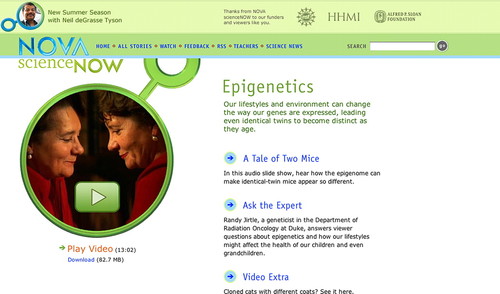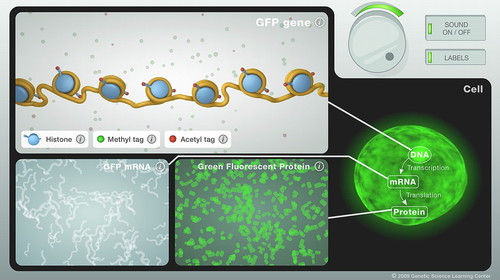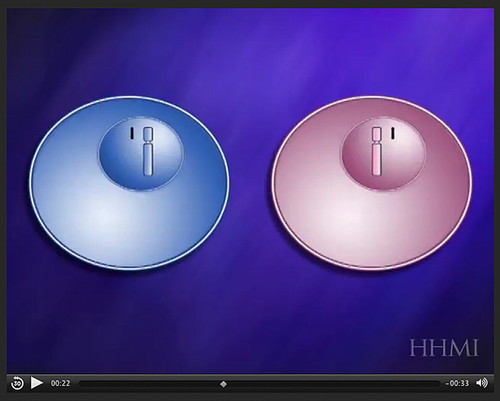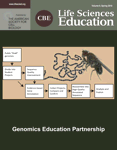Epigenetics Online: Multimedia Teaching Resources
INTRODUCTION
The Human Genome Project, declared complete in 2003, elucidated the sequence of our genome. Researchers are now learning that another level of information—the epigenome—controls gene expression in part by controlling access to DNA. The gene-reading machinery is blocked when methyl molecules bind to DNA or histones. Conversely, when acetyl molecules bind to histones, DNA becomes less tightly wound and genes become available for transcription. The pattern of these chemical tags can be copied across cell divisions and may even be passed on to an individual's offspring. However, because acetylation and methylation are driven by cell signals, the epigenome is dynamic, enabling it to respond to the environment. Thus, epigenetic tags in a cell lineage can change over the course of an individual's lifetime, even leading to differences between identical twins. This feature focuses on multimedia resources that can be used in teaching epigenetics at the undergraduate and secondary level; several hands-on activities also are included.
INTRODUCTION TO EPIGENETICS
One of the first multimedia pieces on epigenetics for a nonscientific audience was the NOVA program, A Ghost in Your Genes, which originally aired on October 16, 2007. The website for this film at www.pbs.org/wgbh/nova/genes includes a 2-minute, 34-second preview that raises questions about differences between identical twins and suggests that insight about the causes of these differences can be found in epigienetics. This short clip could be used to introduce a lecture on this topic.
A longer 13-minute, 2-second video is available on the NOVA scienceNOW website at www.pbs.org/wgbh/nova/sciencenow/3411/02.html (Figure 1). Like the shorter clip, it addresses differences between identical twins. It also provides a brief introduction to epigenetic tags and how they work, introduces Randy Jirtle's research showing how methylation affects coat color in agouti mice, shows research data comparing gene expression patterns in younger and older identical twins, and interviews cancer patients who participated in a clinical trial using epigenetic therapy. Unfortunately, one of the illustrations could lead to a misconception: a reference to the fact that identical twins come from the same egg shows two fully formed infants within a sphere that one assumes is meant to represent the egg. The video can be viewed in low or high resolution by using either QuickTime or Windows Media Player (Microsoft, Redmond, WA). It also can be downloaded as an 82.7-MB mp4 file, enabling instructors to show it without a live Internet connection. A transcript of the video is available on the website, facilitating access to the content by individuals who are hearing impaired. Both film and video have the high production values, engaging approach, and accessible content level that one expects from NOVA.

Figure 1. The NOVA scienceNOW website offers a video, audio slide show, and other resources that provide an introduction to epigenetics.
The NOVA scienceNOW site includes several additional resources. An audio slide show, A Tale of Two Mice, includes five sections: The Agouti Sisters (50 seconds), The Epigenome (1 minute, 6 seconds), Switching on the Agouti Gene (1 minute, 46 seconds), Repairing the Epigenome (49 seconds), and Nature or Nurture? (53 seconds). In it, Dana Dolinoy, a postdoctoral fellow in Randy Jirtle's laboratory at Duke University (Durham, NC), describes the lab's research on factors affecting coat color in agouti mice. In a particularly interesting experiment, pregnant agouti mice were fed bisphenol A (BPA), a common chemical found in plastic food and beverage containers, including baby bottles. More of their offspring were obese and had yellow coats, indicating lower DNA methylation levels. In a second experiment, supplementing the diets of pregnant agouti mice with methyl-rich foods such as folic acid or the genistein found in soy products, while also feeding them BPA, led to increased numbers of brown, slimmer mice with higher DNA methylation levels. Each slide includes a brief text description that would be helpful for hearing-impaired individuals. Although the quality of the narration is a bit uneven, I appreciated having a female researcher narrate the slide show because the scientists in the video are all male. This slide show might best be used as a resource for students to view on their own. In the Ask the Expert part of the site, interested students may also read Randy Jirtle's answers to questions viewers submitted.
An associated Teacher's Guide on epigenetics is aimed at the secondary level (www.pbs.org/wgbh/nova/teachers/programs/3411_02_nsn.html). It summarizes the video content, provides discussion and activity suggestions for before and after watching the video, lists relevant National Science Education Standards, and includes links to several text-based websites and articles. Instructions are provided for constructing a model of chromatin from three rubber surgical tubes to illustrate its tight coiling. Using lengths of rubber tubing to represent the two sides of the DNA double helix is a reasonable model. However, using a length of the same tubing to represent the histones around which DNA is wrapped might lead to misconceptions about both the structure and composition of histones. In addition, the activity incorrectly states that methylation of the chromatin allows it to uncoil so that the DNA is available for transcription; this should be acetylation of the histones.
EPIGENETICS IN A BIT MORE DEPTH
The Epigenetics module on the Genetic Science Learning Center's Learn.Genetics website at http://learn.genetics.utah.edu/content/epigenetics/ (Figure 2) includes eight sections.

Figure 2. The Epigenetics module on Learn.Genetics includes videos, animated interactives, and slide shows that introduce the topic as well as materials that explore it in more depth.
The Epigenome at a Glance section is a 1-minute, 46-second video that provides an introduction to epigenetic tags on DNA and histones, their effect on gene accessibility, and their ability to change in response to the environment. It could be used at the beginning of a lecture focusing on epigenetic tags and their effects; the large version is suitable for projection.
The Gene Control section features an interactive animation that allows the user to take the role of a cell signal controlling expression of a green fluorescent protein (GFP) reporter gene. Turning the control knob one way adds acetyl tags to the histones and loosens DNA winding about them, increasing the production of GFP mRNA, and subsequently GFP protein, which fluoresces. Turning the knob the other way removes the acetyl tags, replaces them with methyl tags on the DNA and histones, and thus decreases production of GFP mRNA and protein. Clicking on “i” buttons brings up additional information on each component of the process. The animation can assist students in making connections among types of epigenetic tags, mRNA formation, and protein production. Additional content on this page discusses how epigenetic abnormalities can lead to cancer.
The Epigenetics and Inheritance section includes a short slide show with examples of epigenetic inheritance in Daphnia, laboratory rats, humans, and two plant species. These examples could easily be incorporated into a lecture. The page also discusses epigenetic inheritance across generations as well as reprogramming in eggs and sperm; a linked page discusses imprinting.
The Epigenetics of Identical Twins movie (4 minutes, 48 seconds) in the Insights From Identical Twins section provides a quirky look at epigenetics using everyday objects as models. It briefly describes the role of epigenetic tags in activating and silencing genes during development and introduces different types of environmental factors that can cause changes in the epigenome, leading to differences in identical twins as they age. The large version is appropriate for showing in class. The page also provides information on insights gained from twin studies.
The Lick Your Rats section explores how the level of maternal nurturing influences the epigenomes of rat pups, leading to calm or anxious behavior throughout the pups' lives. A 45-second video, taken in the laboratory, shows a nurturing rat mother caring for her pups. One section of an interactive animation allows the user to take the role of a rat mother licking and grooming its pup. A coordinated animation shows how the level of attention affects epigenetic tags and thus the expression of the glucocorticoid receptor gene, which affects how well a rat can relax after stress. Users receive feedback on how the amount of nurturing they provided influenced their pup's epigenome and behavior. The second section is an animated slide show that describes how a rat mother's behavior affects her pups' genes, their brains, and their behavior as adults. The animation could be incorporated into a lecture or assigned to students to look at on their own. Both audio and text are available to deliver the content in each section. Additional content on the page explores the topic in slightly more depth and includes a 2-minute, 4-second video clip of Moshe Szyf (McGill University, Montreal, QC, Canada) talking about his research on rat behavior and epigenetics.
Other sections in this module include the Epigenome Learns from Its Experiences, Nutrition and the Epigenome, and Epigenetics and the Human Brain. The latter section features a 7-minute, 35-second video clip of Moshe Szyf talking about the epigenetic link between child abuse and suicide risk. A strength of all the materials on the site is the inclusion of references from the primary literature; links are provided to articles available online.
The companion Teach.Genetics website at http://teach.genetics.utah.edu/content/epigenetics offers resources for instructors. The DNA and Histone Model activity reinforces students' online learning through a hands-on experience. Students cut out templates to create a model that allows them to wrap DNA around histones and explore how the addition of methyl or acetyl tags influences the tightness of DNA wrapping and its accessibility for transcription. A 6-minute, 28-second video provides a tutorial on conducting the activity and could be used to lead students through it. A handout—Your Environment, Your Epigenome—encourages students to consider how their diet, physical activity, and stress level are influencing their epigenome; students record these factors over a 24-hour period. Example assessment questions are provided for each section on the Learn.Genetics site. Moshe Szyf's entire lecture on “The Epigenome as an Interface Between the Social Environment and Our Genome” (from which video clips were excerpted for the materials on Learn.Genetics) is provided in three segments (28 minutes, 47 seconds; 43 minutes, 53 seconds; and 27 minutes, 47 seconds).
Instructors who plan to use materials from both the NOVA and the Learn.Genetics sites need to be aware that the sites use different colors for representations of methyl molecules—red in the NOVA materials and green in the Utah materials. The red color is probably more intuitive for students because methyl tags block transcription.
X INACTIVATION
In female mammalian cells containing two X chromosomes, one of the chromosomes is inactivated to control for dosage effects of genes located on that chromosome. Three short multimedia resources address this topic. A 55-second animation with audio explanation on the Howard Hughes Medical Institute (HHMI) Biointeractive site shows how one copy of the X chromosome is randomly inactivated in each cell, leading to mozaicism in the organism (www.hhmi.org/biointeractive/neuroscience/x_inactivation.html; Figure 3). A 22-second “video extra” on the NOVA Science Now site at www.pbs.org/wgbh/nova/sciencenow/3411/02.html shows the calico cat Rainbow and her cloned kitten, which has a different coat pattern. A 1-minute, 44-second learning object on the McGraw Hill website for Robert F. Weaver's Molecular Biology text goes into slightly more detail, describing the initiation, spreading, and maintenance phases of X inactivation (http://highered.mcgraw-hill.com/sites/0072995246/student_view0/chapter24/x_inactivation.html). The minimal animation, didactic tone of the narrator, and quiz on the page make this animation more appropriate for students to use on their own, rather than for classroom projection.

Figure 3. A short animation on the HHMI Biointeractive site illustrates how X inactivation works in female mammalian cells.
ACKNOWLEDGMENTS
I thank A. Malcolm Campbell for critical comments and helpful suggestions on this article.



